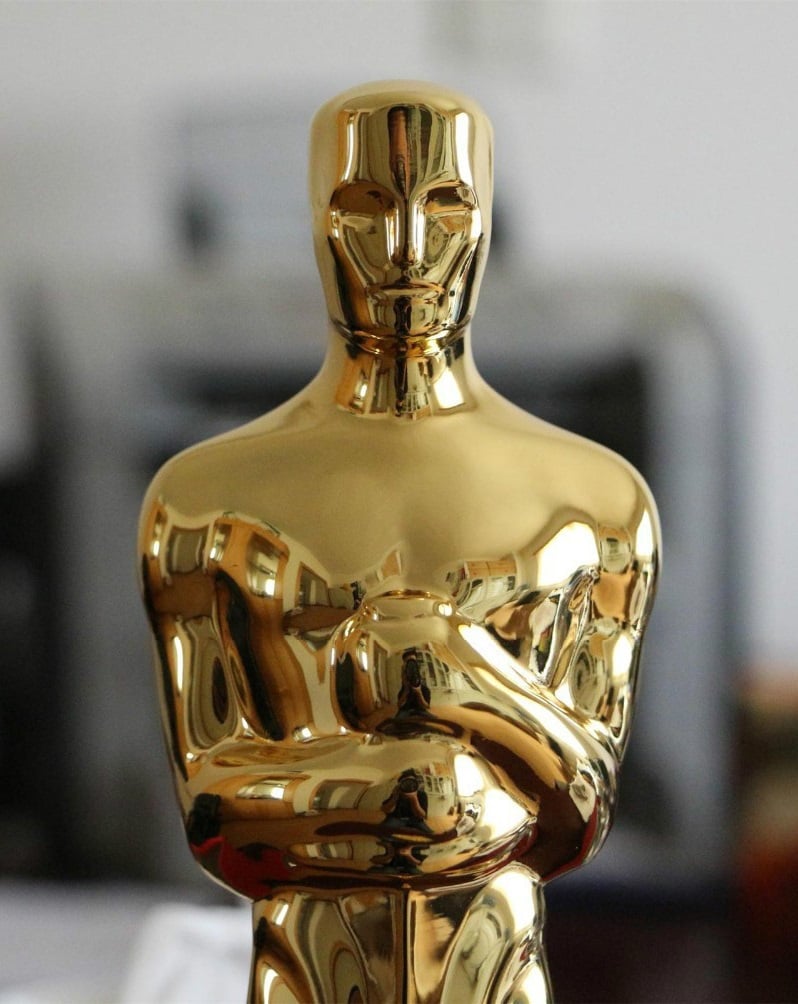Los Angeles (Special to OscarsMovieNews.com) – How did The 96th Oscars come to be defined by its statue? Shortly after the Academy of Motion Picture Arts and Sciences was incorporated in 1927, a dinner was held in the Crystal Ballroom of the Biltmore Hotel in downtown Los Angeles to discuss the goals of the new organization.
One of those goals was devising a method to honor outstanding achievements, thus encouraging higher levels of quality in all facets of motion picture production.
At one of the many meetings in the following weeks, MGM art director Cedric Gibbons sketched the figure of a knight gripping a sword, standing in front of a film reel. The five spokes of the reel stood for the original five branches of the Academy – actors, directors, producers, technicians and writers – and the sword symbolized protection for the welfare and advancement of the industry.
The design was immediately adopted by the Board of Directors and graced the cover of the November 1927 issue of the Academy magazine. In early 1928, Gibbons chose Los Angeles sculptor George Stanley to realize his design in three dimensions.
Together, they discussed the design concept – no live models or sketches were used – and Stanley worked up several versions from which Gibbons selected one. In the finished design, the figure of the knight was streamlined, and the film reel moved beneath its feet. The now iconic statuette was born.
Since the initial awards banquet on May 16, 1929, in the Hollywood Roosevelt Hotel’s Blossom Room, more than 3,000 statuettes have been presented. Each January, additional new golden statuettes are hand-cast in bronze by UAP Polich Tallix before receiving its 24-karat gold finish by Epner Technology, a renowned high-tech specification electroplating company in Brooklyn.
The statuette stands 13½ inches tall and weighs a robust 8½ pounds. The design of the statuette has never changed from its original conception, but the size of the base varied until the present standard was adopted in 1945. Officially named the Academy Award® of Merit, the statuette is better known by its nickname, Oscar, the origins of which aren’t clear. A popular story has been that Academy librarian and eventual executive director Margaret Herrick thought it resembled her Uncle Oscar and said
so, and that the Academy staff began referring to it as Oscar.
In any case, by the sixth Awards presentation in 1934, Hollywood columnist Sidney Skolsky used the name in his column in reference to Katharine Hepburn’s first Best Actress win. The Academy itself didn’t use the nickname officially until 1939.
The 15 statuettes presented at the initial ceremonies were gold-plated solid bronze. Within a few years, the bronze was abandoned in favor of Britannia metal, a pewter- like alloy, which made it easier to give the statuettes their smooth finish. Because of the metal’s shortage during World War II, Oscars® were made of painted plaster for three years. Following the war, all the awarded plaster figures were exchanged for gold-plated metal ones.
Achievements in up to 23 regular categories will be honored on March 10, 2024, at the 96th Oscars® presentation. However, the Academy won’t know how many statuettes it will hand out until the envelopes are opened on Oscar Night®. Although the number of categories will be known prior to the ceremony, the possibility of ties and of multiple recipients sharing the prize in some categories makes the exact number of Oscar statuettes to be presented unpredictable.
As in previous years, any surplus awards will be housed in the Academy’s vault until next year’s event.
The Oscar statuette is the most recognized award in the world. Its success as a symbol of achievement in filmmaking would doubtless amaze those who attended that dinner more than 90 years ago, as well as its designer, Cedric Gibbons. It stands today, as it has since 1929, without peer, on the mantels of the greatest filmmakers in history.
